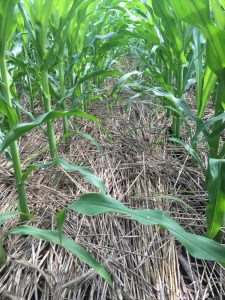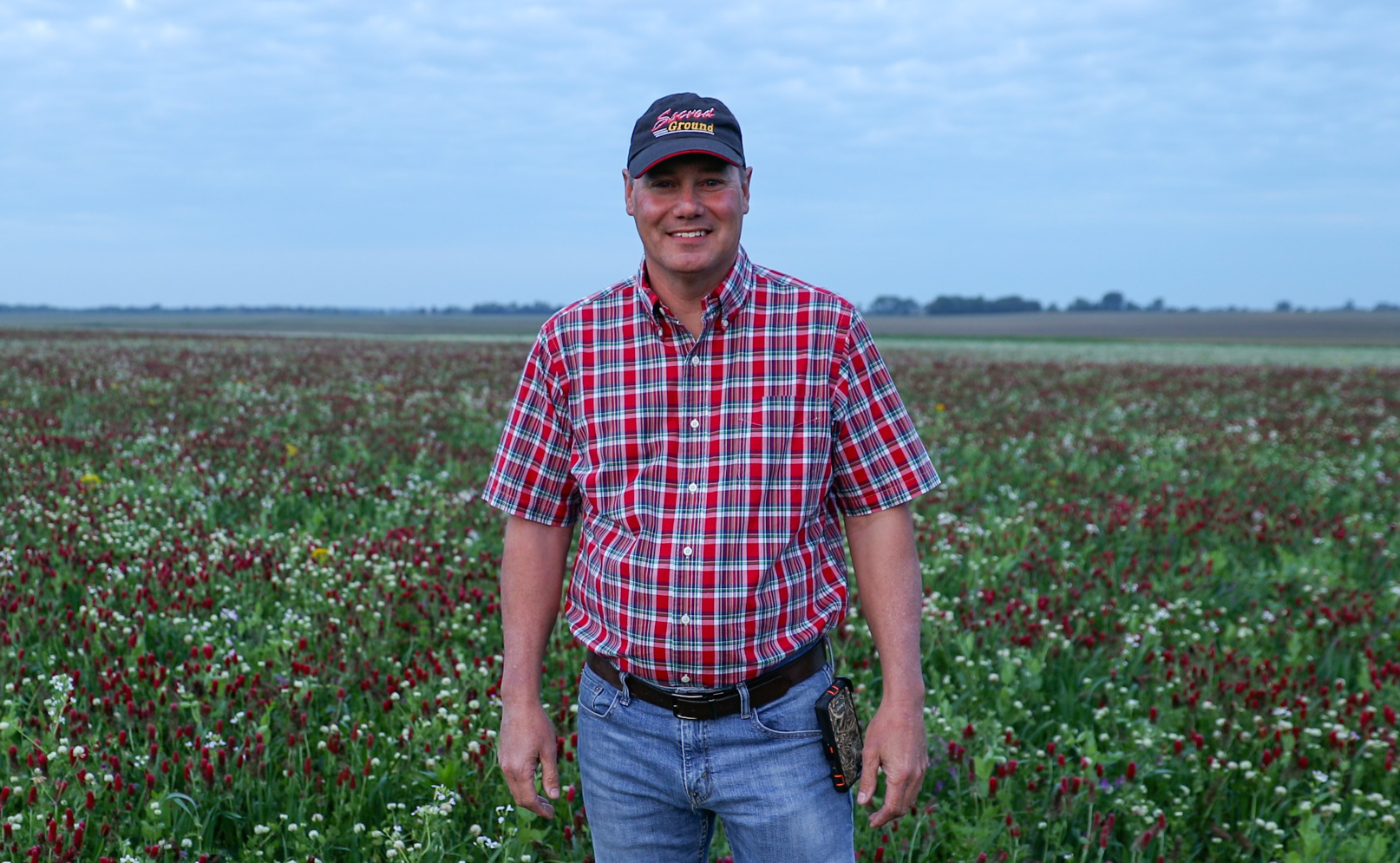When yogurt maker Dannon announced in 2016 that it would transition its products to non-GMO verified, they had to rely on farmers to provide non-GMO feed for the dairy cows that produce milk for its yogurt. One of those farmers is Rick Clark, a fifth generation farmer in Warren County, Indiana.
Clark produces non-GMO corn for Dannon but he does much more than that. He has developed a unique system for building soil health, while producing profitable cash crops. Clark’s farm offers a practical, proven example of how regenerative farming methods can transform agriculture.
“Diversification drives the system”

Rick Clark plants corn directly into cereal rye cover crop
Rick Clark’s family has lived on the farm since the 1880s. Today it encompasses 7000 acres. Like many large Midwest farms, Clark’s farm produces corn and soybeans. But the similarities end there. Clark uses diverse crop rotations, which help to reduce weeds and insects, while also reducing the need for chemical pesticides.
“Diversification drives the system,” he says.
One-third of his farm is in a three-year rotation with corn, soybeans, and wheat. Another third is in a four-year crop rotation—corn, soybeans, wheat, and alfalfa—for a dairy that produces milk for Dannon. The final third is in transition to organic.
Clark has planted all non-GMO crops since 2014 when a nearby dairy asked him to grow non-GMO corn for feed. This led to his partnership with Dannon.
“Within 36 hours of the truck leaving the dairy, the milk is processed into a cup of non-GMO yogurt,” Clark says.
Dannon pays Clark a premium for growing non-GMO corn.
Clark also sells non-GMO alfalfa to the dairy and grows non-GMO soybeans and sells them for a premium price to a Cargill facility in Lafayette, Indiana.
Non-GMO seed is cheaper and yields as much as GMO seed, according to Clark.
Beyond the economic incentives, Clark says: “I just prefer to not plant GMO seed, and I want to have a symbiotic relationship with Mother Nature.”
The symbiotic relationship Clark refers to focuses on building the health and fertility of his soil. “I care deeply about building soil health and will sacrifice yield to maintain soil health,” he says.
Cover crop mixes and “farming green”
To build soil health, Clark plants diverse “cocktails” of cover crops and practices no-till farming by not plowing his fields, which disturbs the soil. He has planted cover crops for the past 10 years and practiced no-till farming with corn for 10 years and soybeans for 15 years.
Clark plants a mixture of cover crops in the fall before the next spring’s corn planting. He calls the mixture “gunslinger,” and it includes five crops that each performs a necessary function for soil health. Haywire forage oats build biomass to protect the soil, sorghum sudangrass promotes the growth of beneficial mycorrhizal fungi, tillage radish helps break up compacted soil, and Austrian winter peas and balansa clover add nitrogen, an essential nutrient.
As with his main cash crops, Clark emphasizes the importance of cover crop diversity. “I’m going to put out as many things as I possibly can in that cocktail for diversification. “We can fall into a trap of a monoculture in cover crops just like we can fall into a trap of monoculture in cash crops.”
Clark also plants cover crops such as cereal rye in the fall before planting soybeans the next spring.
He plants corn and soybeans directly into the cover crops in the spring, a practice he calls “farming green.” “We will not plant our corn or soybean crops unless it is into green growing cover crops,” he says.
Clark plants earlier maturing varieties of corn and soybeans in the spring so he can harvest and plant cover crops earlier in the fall.
He has seen many other benefits from farming green. These include regenerating and preserving nutrients in the soil, adding nitrogen to the soil, preventing soil erosion, increasing biomass to add “armor” to the soil, reducing water evaporation, and suppressing weeds.
Clark has also dramatically decreased the use of chemical fertilizers and pesticides.
“We use no seed treatments, no insecticides, and no fungicides. We are to the point where we have nearly eliminated synthetic fertilizers. We only use a little nitrogen on our non-GMO crops. So our cost of production is extremely low.”
Meanwhile, his crop yields are high. “We’re extremely profitable,” Clark says.
Transitioning 1/3 of farm to organic
After reducing chemical inputs, the next logical step would be to grow organic, and Clark is doing that for the “challenge.”
“I also want to continue to make the farm better for the next generation,” he says.
He is transitioning 2000 acres and will have 400 acres certified organic this June. He plans to grow organic corn using his system of cover crops and no-till.
Clark admits that practicing no-till in organic is a challenge. Few organic farmers practice no-till farming; many continue to plow their fields to eliminate weeds.
“Some people think this (no-till organic) sounds crazy, but that’s normal for me,” Clark says. “If I can get this figured out, it should be a pretty big deal.”
Many farmers who convert to organic face challenges selling their transitional crops, but Clark has an advantage.
“I can use alfalfa as my transition acres. It is easy to grow and I can sell it to the dairy.”
Clark is confident he can produce strong yields of organic corn this year, his first producing a certified organic crop.
“At $10 a bushel (paid for organic corn) that is quite a return on your investment,” he says.
Regenerative, not sustainable agriculture
Regenerative agriculture with its focus on soil health is a major trend, and Rick Clark is on the leading edge.
He doesn’t use the word “sustainable.” “That means staying the same,” he says. “I prefer the word ‘regenerative,’ and I have a systematic approach to regenerative farming.”
He defines soil health simply as “decreasing inputs and increasing yield.” “If your inputs are going down, and your yields are going up, how can you not be building soil health? And that is exactly what this farm is doing.”
Regenerative agriculture is about creating balance. “The fungus to bacteria ratio is getting in balance. Predator to prey insects is getting in balance. That is why I don’t need to use insecticides. I don’t have the imbalance of corn rootworm eating my roots,” he says. “I have the predator that preys on corn rootworm in my system.”
Rick Clark’s success has been recognized. In 2017, he was honored as Dannon’s Sustainable Farmer of the Year. More recently, Land O’ Lakes honored him with an Outstanding Sustainability Award, and he was also a regional winner of the American Soybean Association’s Conservation Legacy Award.
Clark’s farm was also chosen, along with 15 other farms in the U.S., to be researched by soil health experts as part of Danone North America’s $6 million soil health research project. The project aims to identify ways to regenerate soils and provide training in soil health best practices to farmers.
Clark is happy to share his knowledge of regenerative agriculture with other farmers. He is often asked to speak at conferences such at the National No-Till Conference this past January in Indianapolis. Soil health is gaining traction among farmers nationwide, and he is confident that others can succeed as he has. He says he “wants to help people.”
“What I like about this is that I’m just a farmer in Indiana, and if other farmers have a plan and care about building soil health they can achieve these things too.”









